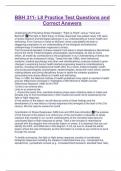BBH 311- L8 Practice Test Questions and
Correct Answers
Challenging the Prevailing Stress Paradigm: "Fight-or-Flight" versus "Tend-and-
Befriend" ✅The fight-or-flight theory of stress responses has guided nearly 100 years
of stress research and stimulated advances in our understanding of human health and
well-being. From Cannon to Selye to McEwen, there undoubtedly has been a
staggering progression in our understanding of the biological and behavioral
underpinnings of mammalian responses to stress.
The first several decades of stress research took place in siloed disciplinary laboratories
around the world. Endocrinologists, physiologists, psychologists, as well as many
others, all made key contributions to the progression in our understanding of stress and
well-being as we understand it today. Toward the late 1980s, when behavioral
medicine, medical psychology and other new interdisciplinary sciences started to grow,
changes in examining human health started progressing toward an interdisciplinary
science, including the biobehavioral health field. As a result, endocrinologists, health
and social psychologists, physiologists, epidemiologists, along with many others, started
rubbing elbows and joining disciplinary forces to tackle the complex questions
surrounding how stress affects our health and well-being.
Then, in 1995, the National Institute of Health published a key report on women's health
and sex differences (reviewed in "Highlights of NIH Women's Health and Sex
Differences Research (1990-2010") PDF
(Links to an external site.)
Links to an external site.
). Around the same time, scientists studying stress were collecting data on males and
females only to find inconsistencies in their results that could not be explained by the
fight-or-flight response.
In this section of the lesson, we will discuss some of these findings and the
development of a new theory of stress responses that emerged at the start of the 21st
century. We first need to review the coordi
Coordination of Stress Responses: SAM-Axis and HPA-Axis Activation ✅The purpose
of this first part of the lesson is to remind you of the culmination of decades of stress
research that resulted in our current understanding of the intricately balanced and
coordinated fight-or-flight response to stress. Take a few minutes to refamiliarize
yourself with this diagram from the earlier lesson on stress. It is important that you can
identify the HPA- and SAM-axis in this diagram. If not, be sure to reread the earlier
lesson where this was introduced, as this information is crucial as you continue to work
through this course.
To briefly summarize, the fight-or-flight stress response consists of coordinated
biological responses including the release of catecholamines (e.g., norepinephrine,
epinephrine), sympathetic arousal (e.g., increased blood pressure, elevated heart rate),
, and hypothalamic-pituitary-adrenal (HPA) axis activation (e.g., cortisol secretion from
the adrenal glands).
HPA-axis stress activation includes a cascade of neuroendocrine responses beginning
with the release of corticotropin releasing hormone (CRH) from the paraventricular
nucleus of the hypothalamus, which stimulates release of adrenocorticotropin hormone
(ACTH) from the anterior pituitary, as well as vasopressin and oxytocin from the
posterior pituitary gland. ACTH in turn stimulates the adrenal cortex to release
glucocorticoids, including corticosteroids (e.g., cortisol, corticosterone). These
hormones regulate HPA-axis activation, and occur in concert with one another to
mobilize energy stores so that an organism can adapt to stressors.
Decades of stress research confirm that repeated and chronic activation of these stress
responses can have negative health consequences through dysregulation of the HPA-
axis negative feedback loop and alterations in immune function.
For example, prolonged stress exposure appears to u
Scientific Support for "Flight-or-Flight" ✅Before the NIH published its report in 1995
and required equal representation of males and females in their funded research
portfolios, the majority of stress research had been conducted on males (both humans
and animals). In fact, before 1995, only 17% of all participants in stress studies were
women. Further, most of what we have known about the biobehavioral effects of stress
until recently has come from research with male rats.
The obvious problem with this lack of inclusion is that many of the key assumptions
made about stress, human health and well-being are based on half the population. The
result is that assumptions have been made about biobehavioral health functioning
among women based on male responses. Although it may be easy today to look back
and criticize scientists for assuming biobehavioral similarities among women and men, it
is important to remember the social context decades ago where it was viewed as
politically incorrect to highlight how men and women might differ biologically.
This climate began to change with the first female director of the NIH (1991-1993), Dr.
Bernadine P. Healey, a cardiologist who championed studies that overturned false
assumptions about women's health, including clinical presentation of heart attacks,
heart disease risk, and HIV progression. In 1991, she wrote in the New England Journal
of Medicine, "The problem is to convince both the lay and medical sectors that coronary
heart disease is also a woman's disease, not a man's disease in disguise." So, too,
might biobehavioral stress responses be a female response, and not a male stress
response in disguise.
Indeed, scientific studies in the early 1990s comparing sex differences in stress
responses among rats suggested that this could be the case.
Part 1: Behavioral Responses to Stress ✅Klein and colleagues (1998) examined sex
differences in the effects of intermittent, unpredictable and uncontrollable mild footshock
stress on behavioral stress responses levels in male and female rats. The results are
shown in the graph below.





